VRA:用于分布外检测的变分校正激活
摘要
分布外 (OOD) 检测对于在开放世界中构建可靠的机器学习系统至关重要。 研究人员提出了各种策略来减少模型对 OOD 数据的过度自信。 其中,ReAct是处理模型过度自信的典型且有效的技术,它截断高激活以增加分布内和OOD之间的差距。 尽管其结果很有希望,但这种技术是最好的选择吗? 为了回答这个问题,我们利用变分方法来寻找最优操作,并验证了 OOD 检测中抑制异常低和高激活以及放大中间激活的必要性,而不是像 ReAct 那样只关注高激活。 这促使我们提出一种称为“变分整流激活(VRA)”的新技术,该技术使用分段函数模拟这些抑制和放大操作。 多个基准数据集的实验结果表明,我们的方法优于现有的事后策略。 同时,VRA兼容不同的评分函数和网络架构。 我们的代码可以在补充材料中找到。
1简介
现实世界中部署的系统经常遇到分布外(OOD)数据,即来自不相关分布的样本,其标签集与训练数据没有交互。 大多数现有系统往往会对 OOD 数据产生过度自信的估计,严重影响其可靠性[1]。 因此,研究人员提出了OOD检测任务,旨在确定样本是来自分布内(ID)还是OOD。 该任务允许模型在面对不熟悉的样本时拒绝识别。 考虑到其重要性,OOD检测越来越受到研究人员的关注,并已应用于自动驾驶[2]和医疗诊断[3]等许多安全要求较高的领域。 >。
在OOD检测中,现有的方法可以大致分为两类:需要训练的方法和事后策略的方法。 第一类通过训练时正则化[4, 5]或外部OOD样本[6, 7]来识别OOD数据。 但它们需要更多的计算资源并且在实际应用中不方便。 为此,研究人员提出了直接使用预训练模型进行 OOD 检测的事后策略。 由于易于实施,这些方法近年来引起了越来越多的关注。 其中,React[8]是一种典型的事后策略,它通过截断异常高的激活来增加ID和OOD之间的差距,从而提高检测性能。 但这样的操作是拉开差距的最佳选择吗?
为了回答这个问题,我们使用变分法来求解最优操作。 基于此操作,我们揭示了 OOD 检测中抑制异常低和高激活以及放大中间激活的必要性。 然后,我们提出了一种简单而有效的策略,称为“变分整流激活(VRA)”,它使用分段函数模拟抑制和放大操作。 为了验证其有效性,我们在多个基准数据集上进行了实验,包括 CIFAR-10、CIFAR-100 以及更具挑战性的 ImageNet。 实验结果表明,我们的方法优于现有的事后策略,创造了新的最先进记录。 本文的主要贡献可概括如下:
-
•
(理论)从变分法的角度来看,我们找到了最大化ID和OOD之间差距的最佳操作。 该操作验证了抑制异常低和高激活以及放大中间激活的必要性。
-
•
(方法)我们提出了一种简单而有效的事后策略,称为 VRA。 我们的方法与各种评分函数和网络架构兼容。
-
•
(性能)基准数据集上的实验结果证明了我们方法的有效性。 VRA 优于 OOD 检测中现有的事后策略。
2方法论
2.1问题定义
令 为输入空间, 为具有 不同类别的标签空间。 考虑对包含 标记样本 的数据集进行监督分类任务,其中 是样本 的真实标签。 理想情况下,所有测试样本都来自与训练数据相同的分布。 但实际上,测试样本可能来自未知的分布,例如标签集与没有交集的不相关分布。 在本文中,我们使用表示的边际分布,使用表示OOD数据的分布。 在本文中,我们的目标是确定样本是来自 ID 还是 OOD。
2.2动机
在所有方法中,ReAct 是一种典型且有效的事后策略[8]。 假设是倒数第二层的特征向量,表示特征维度。 为了方便起见,我们使用 作为 的简写。 对于每个 ,ReAct 会截断高于阈值 的激活:
| (1) |
其中 相当于没有截断的模型。 ReAct 已经证明这种截断操作可以增加 ID 和 OOD [8] 之间的差距:
| (2) |
尽管其结果令人鼓舞,但该策略是否是扩大 ID 和 OOD 之间差距的最佳选择? 在本文中,我们尝试借助变分法来回答这个问题。
2.3VRA框架
为了找到最佳操作,我们应该优化以下目标:
-
•
最大化 ID 和 OOD 之间的差距。
-
•
最小化操作带来的修改,最大限度地保留输入。
最终目标函数计算如下:
| (3) |
其中 控制两个损失之间的权衡。 求解方程。 3,我们首先做出一个温和的假设,以确保函数空间足够复杂。
假设1
我们假设 、、 和 存在。 令 为希尔伯特空间:
| (4) |
这个空间足够复杂,包含大多数函数,例如恒等函数、常数函数和所有有界连续函数。 然后,我们定义的内积如下:
| (5) |
结合这个假设,方程的等效方程。 3 是:
| (6) |
然后,我们利用变分法来求解函数极值。 我们将标记为最优解。 和 ,然后我们有:
| (7) |
它可以转换为:
| (8) | |||
| (9) |
然后,我们有:
| (10) |
结合假设1和的任意性,我们可以得到:
| (11) |
考虑到假设1和的任意性,我们有:
| (12) |
因此,最优激活函数为:
| (13) |
为了验证其有效性,我们将最优函数 与未校正函数 进行比较。 由于 是最优解,因此在式(1)中应该得到较小的值。 3:
| (14) |
方程的等效方程。 14 是:
| (15) |
它表明将ID和OOD之间的差距扩大了至少。
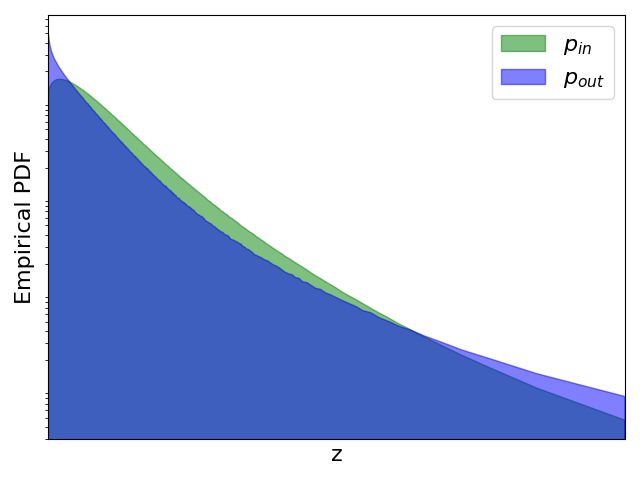
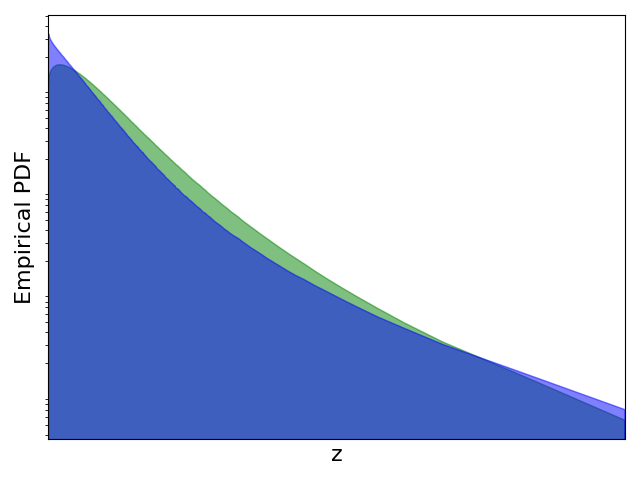
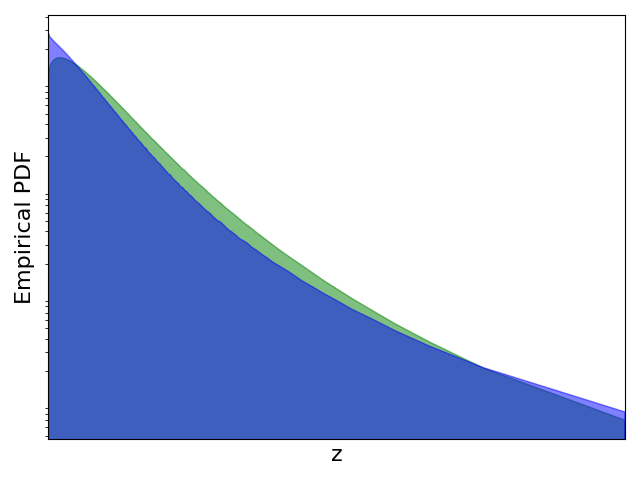
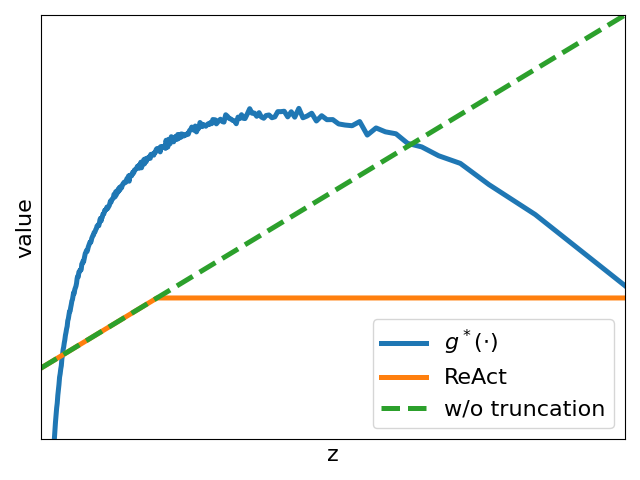
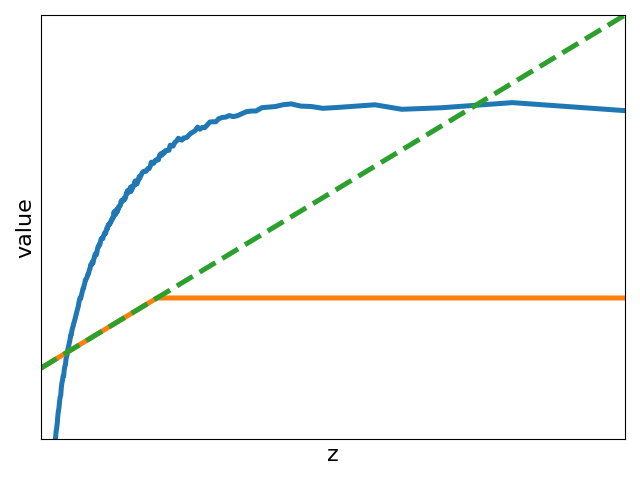
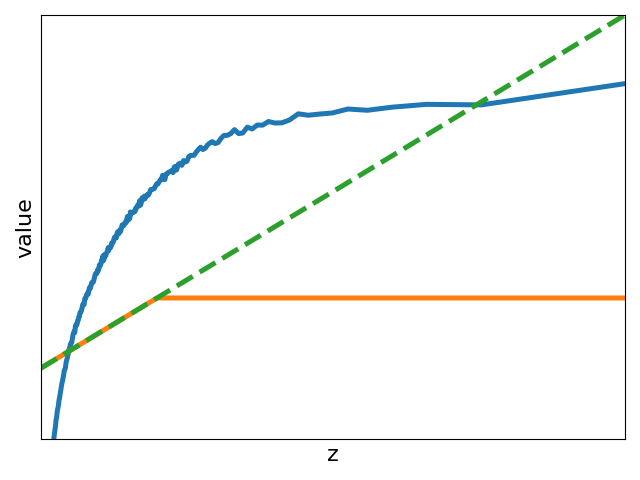
2.4实际实现
通过理论分析,我们找到了可以最大化ID和OOD之间差距的最优操作。 但实际上,这个操作取决于和的具体表达。 鉴于 OOD 数据来自未知分布[9],估计这些表达式是一项具有挑战性的任务。 这促使我们寻找更实际的实现。
为此,我们将 ImageNet 视为 ID 数据并选择多个 OOD 数据集。 我们首先使用直方图来近似和的概率密度函数。 然后,我们计算 并将其与 ReAct 进行比较,ReAct 的阈值设置为根据 ID 数据估计的激活的第 90th 百分位,与原始论文 [8 一致]。 实验结果如图1所示。 与没有截断的模型相比,我们观察到 ReAct 抑制了高激活(见图1(d)1(f))。 与ReAct不同,最优操作进一步证明了在OOD检测中抑制异常低激活的必要性。 为了模拟此类操作,我们设计了一个名为 VRA 的分段函数:
其中 和 是确定低激活和高激活的两个阈值。 显然,和代表没有激活截断的模型; 和表示相当于ReAct的模型。 因此,我们的方法是一个更通用的操作。 由于不同的特征具有不同的分布,因此我们提出了一种自适应调整策略来确定和。 具体来说,我们预定义满足的和。 然后,我们将 ID 数据上估计的激活的 -分位数(或 -分位数)视为 (或 ) 。 同时,我们观察到放大了图1(d)1(f)中的中间激活。 因此,我们提出了 VRA 的另一种变体 VRA+,它进一步引入了一个超参数 来控制放大程度:
3实验
3.1实验设置
语料库描述
与之前的工作一致,我们针对不同的 ID 数据集 [8, 10] 考虑不同的 OOD 数据集。 对于 CIFAR 基准测试 [11] 作为 ID 数据,我们使用官方/测试分割作为 ID 数据,并选择六个数据集作为 OOD 数据:纹理 [12]、SVHN [13]、Places365 [14]、LSUN 裁剪 [15]、LSUN 调整大小 [15]、和 iSUN [16];对于 ImageNet [17] 作为 ID 数据,由于更大的标签空间和更高分辨率的图像,它比 CIFAR 基准更具挑战性。 为了确保ID和OOD之间的类别不重叠,我们从四个数据集中选择一个子集作为OOD数据,与之前的工作[8, 10]一致:iNaturalist [18]、SUN [19]、地点 [14] 和纹理 [12]。
基线
为了验证我们方法的有效性,我们实现了以下最先进的事后策略作为基线:1)MSP [20] 是直接利用最大 softmax 的最基本方法识别 OOD 数据的概率; 2)ODIN [21]使用温度缩放和输入扰动来增加ID和OOD之间的差距; 3)Mahalanobis[22]计算距离最近的类中心的距离作为指标; 4)Energy[23]用理论上保证的Energy分数代替最大softmax概率; 5) ReAct [8] 应用激活截断来去除异常高的激活; 6)KNN [24]利用非参数最近邻距离进行OOD检测; 7) DICE [10] 利用稀疏化来选择最显着的权重; 8) SHE [25]使用现代Hopfield网络[26]中定义的能量函数。
实施细节
我们的方法包含三个用户特定的参数:阈值和,以及放大程度。 我们从中选择,从中选择,从中选择 。 与之前的工作[8]一致,我们使用高斯噪声图像作为超参数调整的验证集。 默认情况下,我们对 CIFAR 使用 DenseNet-101 [27],对 ImageNet 使用 ResNet-50 [28]。 所有实验均使用 PyTorch [29] 实现,并使用 NVIDIA Tesla V100 GPU 进行。 为了比较不同方法的性能,我们利用了两种广泛使用的 OOD 检测指标:FPR95 和 AUROC。 其中,FPR95衡量ID数据真阳性率为95%时OOD数据的假阳性率; AUROC 测量接受者操作特征曲线下的面积。
3.2实验结果与讨论
主要结果
为了验证我们方法的有效性,我们将基于 VRA 的方法与竞争性事后策略进行比较。 实验结果如表1和表2所示。 我们观察到,我们的方法通常在不同数据集上达到 Top3 性能,并且总体表现最好。 与这些基线不同,我们尝试通过抑制异常低和高激活并放大中间激活来最大化 ID 和 OOD 之间的差距。 这些结果证明了 OOD 检测中此类抑制和放大操作的有效性。 同时,我们观察到 VRA+ 通常优于 VRA,这表明更接近理论最优解的操作通常可以获得更好的性能。
我们还与需要训练的方法进行比较。 MOS [4] 通过训练时正则化解决 OOD 检测问题。 表2中的实验结果表明,我们的方法优于具有相同主干的MOS。 同时,VOS [5] 是一种最新的先进策略,可以合成虚拟异常值以规范训练过程中的决策边界。 根据他们的原始论文,它在 CIFAR-10 上的 AUROC 中达到了 95.33%,在 FPR95 中达到了 22.47%。 在相同的ID数据、OOD数据和网络架构下,我们的方法优于VOS(见表1)。 因此,基于VRA的方法不需要昂贵的训练过程,但可以在OOD检测中获得更好的性能。
| Method | SVHN | LSUN-C | LSUN-R | iSUN | Textures | Places365 | Average | |||||||
|---|---|---|---|---|---|---|---|---|---|---|---|---|---|---|
| FR. | AU. | FR. | AU. | FR. | AU. | FR. | AU. | FR. | AU. | FR. | AU. | FR. | AU. | |
| ID Dataset: CIFAR-10; Backbone: DenseNet-101 [27] | ||||||||||||||
| MSP [20] | 47.27 | 93.48 | 33.57 | 95.54 | 42.10 | 94.51 | 42.31 | 94.52 | 64.15 | 88.15 | 63.02 | 88.57 | 48.74 | 92.46 |
| ODIN [21] | 25.29 | 94.57 | 04.70 | 98.86 | 03.09 | 99.02 | 03.98 | 98.90 | 57.50 | 82.38 | 52.85 | 88.55 | 24.57 | 93.71 |
| Mahalanobis [22] | 06.42 | 98.31 | 56.55 | 86.96 | 09.14 | 97.09 | 09.78 | 97.25 | 21.51 | 92.15 | 85.14 | 63.15 | 31.42 | 89.15 |
| Energy [23] | 40.61 | 93.99 | 03.81 | 99.15 | 09.28 | 98.12 | 10.07 | 98.07 | 56.12 | 86.43 | 39.40 | 91.64 | 26.55 | 94.57 |
| ReAct [8] | 41.64 | 93.87 | 05.96 | 98.84 | 11.46 | 97.87 | 12.72 | 97.72 | 43.58 | 92.47 | 43.31 | 91.03 | 26.45 | 95.30 |
| KNN [24] | 13.51 | 96.68 | 30.95 | 93.82 | 11.37 | 97.72 | 10.79 | 97.91 | 24.50 | 95.19 | 63.88 | 85.00 | 25.83 | 94.39 |
| DICE [10] | 25.99 | 95.90 | 00.26 | 99.92 | 03.91 | 99.20 | 04.36 | 99.14 | 41.90 | 88.18 | 48.59 | 89.13 | 20.84 | 95.25 |
| SHE [25] | 28.12 | 94.72 | 00.76 | 99.84 | 09.73 | 98.15 | 10.99 | 97.95 | 51.98 | 83.07 | 59.35 | 84.16 | 26.82 | 92.98 |
| VRA | 18.75 | 96.68 | 01.32 | 99.63 | 05.80 | 98.69 | 05.70 | 98.69 | 34.89 | 93.42 | 39.98 | 91.69 | 17.74 | 96.47 |
| VRA+ | 13.54 | 97.45 | 02.03 | 99.56 | 06.37 | 98.72 | 06.15 | 98.71 | 27.07 | 95.03 | 39.97 | 91.96 | 15.85 | 96.91 |
| ID Dataset: CIFAR-100; Backbone: DenseNet-101 [27] | ||||||||||||||
| MSP [20] | 81.70 | 75.40 | 60.49 | 85.60 | 85.24 | 69.18 | 85.99 | 70.17 | 84.79 | 71.48 | 82.55 | 74.31 | 80.13 | 74.36 |
| ODIN [21] | 41.35 | 92.65 | 10.54 | 97.93 | 65.22 | 84.22 | 67.05 | 83.84 | 82.34 | 71.48 | 82.32 | 76.84 | 58.14 | 84.49 |
| Mahalanobis [22] | 22.44 | 95.67 | 68.90 | 86.30 | 23.07 | 94.20 | 31.38 | 89.28 | 62.39 | 79.39 | 92.66 | 61.39 | 50.14 | 84.37 |
| Energy [23] | 87.46 | 81.85 | 14.72 | 97.43 | 70.65 | 80.14 | 74.54 | 78.95 | 84.15 | 71.03 | 79.20 | 77.72 | 68.45 | 81.19 |
| ReAct [8] | 83.81 | 81.41 | 25.55 | 94.92 | 60.08 | 87.88 | 65.27 | 86.55 | 77.78 | 78.95 | 82.65 | 74.04 | 65.86 | 83.96 |
| KNN [24] | 23.96 | 93.99 | 70.98 | 73.37 | 76.34 | 76.69 | 70.88 | 78.58 | 37.75 | 87.48 | 95.20 | 59.70 | 62.52 | 78.30 |
| DICE [10] | 54.65 | 88.84 | 00.93 | 99.74 | 49.40 | 91.04 | 48.72 | 90.08 | 65.04 | 76.42 | 79.58 | 77.26 | 49.72 | 87.23 |
| SHE [25] | 41.89 | 90.61 | 01.06 | 99.68 | 78.18 | 73.97 | 72.73 | 76.14 | 61.49 | 76.57 | 85.33 | 70.53 | 56.78 | 81.25 |
| VRA | 70.91 | 87.46 | 10.73 | 98.04 | 38.52 | 93.49 | 38.53 | 93.42 | 47.64 | 90.17 | 76.39 | 78.66 | 47.12 | 90.21 |
| VRA+ | 62.64 | 88.70 | 19.82 | 96.33 | 28.44 | 95.47 | 28.72 | 95.18 | 40.62 | 91.57 | 79.78 | 76.42 | 43.34 | 90.61 |
| Method | iNaturalist | SUN | Places | Textures | Average | |||||
|---|---|---|---|---|---|---|---|---|---|---|
| FR. | AU. | FR. | AU. | FR. | AU. | FR. | AU. | FR. | AU. | |
| Backbone: ResNet-50 [28] | ||||||||||
| MSP [20] | 54.99 | 87.74 | 70.83 | 80.86 | 73.99 | 79.76 | 68.00 | 79.61 | 66.95 | 81.99 |
| ODIN [21] | 47.66 | 89.66 | 60.15 | 84.59 | 67.89 | 81.78 | 50.23 | 85.62 | 56.48 | 85.41 |
| Mahalanobis [22] | 97.00 | 52.65 | 98.50 | 42.41 | 98.40 | 41.79 | 55.80 | 85.01 | 87.43 | 55.47 |
| Energy [23] | 55.72 | 89.95 | 59.26 | 85.89 | 64.92 | 82.86 | 53.72 | 85.99 | 58.40 | 86.17 |
| ReAct [8] | 20.38 | 96.22 | 24.20 | 94.20 | 33.85 | 91.58 | 47.30 | 89.80 | 31.43 | 92.95 |
| KNN [24] | 59.08 | 86.20 | 69.53 | 80.10 | 77.09 | 74.87 | 11.56 | 97.18 | 54.32 | 84.59 |
| DICE [10] | 25.63 | 94.49 | 35.15 | 90.83 | 46.49 | 87.48 | 31.72 | 90.30 | 34.75 | 90.78 |
| SHE [25] | 34.22 | 90.18 | 54.19 | 84.69 | 45.35 | 90.15 | 45.09 | 87.93 | 44.71 | 88.24 |
| VRA | 15.70 | 97.12 | 26.94 | 94.25 | 37.85 | 91.27 | 21.47 | 95.62 | 25.49 | 94.57 |
| VRA+ | 15.48 | 97.08 | 23.50 | 94.91 | 34.62 | 91.79 | 19.66 | 96.08 | 23.31 | 94.97 |
| Backbone: ResNetv2-101 [28] | ||||||||||
| MSP [20] | 63.69 | 87.59 | 79.98 | 78.34 | 81.44 | 76.76 | 82.73 | 75.45 | 76.96 | 79.54 |
| ODIN [21] | 62.69 | 89.36 | 71.67 | 83.92 | 76.27 | 80.67 | 81.31 | 76.30 | 72.99 | 82.56 |
| Mahalanobis [22] | 96.34 | 46.33 | 88.43 | 65.20 | 89.75 | 64.46 | 52.23 | 72.10 | 81.69 | 62.02 |
| Energy [23] | 64.91 | 88.48 | 65.33 | 85.32 | 73.02 | 81.37 | 80.87 | 75.79 | 71.03 | 82.74 |
| ReAct [8] | 49.97 | 89.80 | 65.30 | 87.40 | 73.12 | 85.34 | 80.82 | 70.53 | 67.30 | 83.27 |
| MOS [4] | 09.28 | 98.15 | 40.63 | 92.01 | 49.54 | 89.06 | 60.43 | 81.23 | 39.97 | 90.11 |
| VRA | 27.26 | 95.68 | 34.53 | 93.27 | 47.31 | 90.19 | 30.69 | 94.22 | 34.95 | 93.34 |
| VRA+ | 20.81 | 97.70 | 32.89 | 92.68 | 45.83 | 90.01 | 23.88 | 95.43 | 30.85 | 93.71 |
与评分功能的兼容性
在表 3 中,我们研究了基于 VRA 的方法与不同评分函数(MSP、Energy 和 ODIN)的兼容性。 实验结果表明,我们的方法为所有评分函数带来了性能改进,并且通常比竞争性事后策略获得更好的性能。 这些结果验证了我们的方法在 OOD 检测中的兼容性和有效性。
| Method | CIFAR-10 | CIFAR-100 | ImageNet | Average | ||||
|---|---|---|---|---|---|---|---|---|
| FPR95 | AUROC | FPR95 | AUROC | FPR95 | AUROC | FPR95 | AUROC | |
| MSP [20] | 48.73 | 92.46 | 80.13 | 74.36 | 66.95 | 81.99 | 65.27 | 82.94 |
| MSP + ReAct | 48.00 | 92.77 | 77.69 | 76.22 | 55.63 | 87.85 | 60.44 | 85.61 |
| MSP + DICE | 43.72 | 92.92 | 76.86 | 76.39 | 67.41 | 82.24 | 62.66 | 83.85 |
| MSP + VRA | 42.31 | 93.50 | 79.69 | 75.94 | 47.09 | 89.62 | 56.36 | 86.35 |
| Energy [23] | 26.55 | 94.57 | 68.45 | 81.19 | 58.41 | 86.17 | 51.14 | 87.31 |
| Energy + ReAct | 26.45 | 94.67 | 62.27 | 84.47 | 31.43 | 92.95 | 40.05 | 90.70 |
| Energy + DICE | 20.83 | 95.24 | 49.72 | 87.23 | 34.75 | 90.77 | 35.10 | 91.08 |
| Energy + VRA | 17.74 | 96.47 | 53.24 | 88.74 | 25.49 | 94.57 | 32.16 | 93.26 |
| ODIN [21] | 24.57 | 93.71 | 58.14 | 84.49 | 56.48 | 85.41 | 46.40 | 87.87 |
| ODIN + ReAct | 21.00 | 95.98 | 54.17 | 88.62 | 42.21 | 91.28 | 39.13 | 91.96 |
| ODIN + DICE | 26.05 | 94.62 | 61.39 | 83.83 | 62.89 | 84.48 | 50.11 | 87.64 |
| ODIN + VRA | 17.38 | 96.52 | 47.12 | 90.21 | 32.75 | 93.39 | 32.42 | 93.37 |
性能上限分析
我们提出 VRA 和 VRA+ 来近似 OOD 检测的最佳操作。 但是否有必要设计其他函数以获得更好的近似值? 为了回答这个问题,我们需要揭示是否能够达到上限性能。 估计的核心是估计和的概率密度函数。 为此,我们考虑两种理想情况:VRA-True和VRA-Fake-True。 在第一种情况下,我们假设所有ID和OOD数据都是预先已知的;在第二种情况下,我们从整个数据集中随机选择 1% 的 ID 和 OOD 数据。 这两种情况都利用直方图来估计 和 并使用等式: 13 计算。 考虑到直方图提供了的分段形式,我们直接使用分段函数来表示。 在表4中,我们观察到两种理想情况都可以达到近乎完美的结果。 因此,增加ID和OOD之间差距的可以为OOD检测生成更具区分性的特征。 将来,我们将探索其他可以更好地描述最佳操作以获得更好性能的函数。
| ID | Energy [23] | VRA | VRA-Fake-True | VRA-True | ||||
|---|---|---|---|---|---|---|---|---|
| FPR95 | AUROC | FPR95 | AUROC | FPR95 | AUROC | FPR95 | AUROC | |
| CIFAR-10 | 26.55 | 94.57 | 17.74 | 96.47 | 13.27 | 97.75 | 00.96 | 99.81 |
| CIFAR-100 | 68.45 | 81.19 | 47.12 | 90.21 | 23.62 | 94.20 | 01.58 | 99.69 |
| ImageNet | 58.41 | 86.17 | 25.49 | 94.57 | 13.09 | 96.89 | 03.50 | 99.31 |
参数敏感性分析
VRA 使用两个超参数( 和 )来自适应调整低激活和高激活的阈值。 在本节中,我们进行参数敏感性分析并揭示它们对 OOD 检测的影响。 在图2中,我们观察到当和不合适时,我们的方法表现不佳。 较大的 会抑制太多的低激活,而较大的 则会抑制太少的高激活。 因此,需要为VRA选择合适的和。
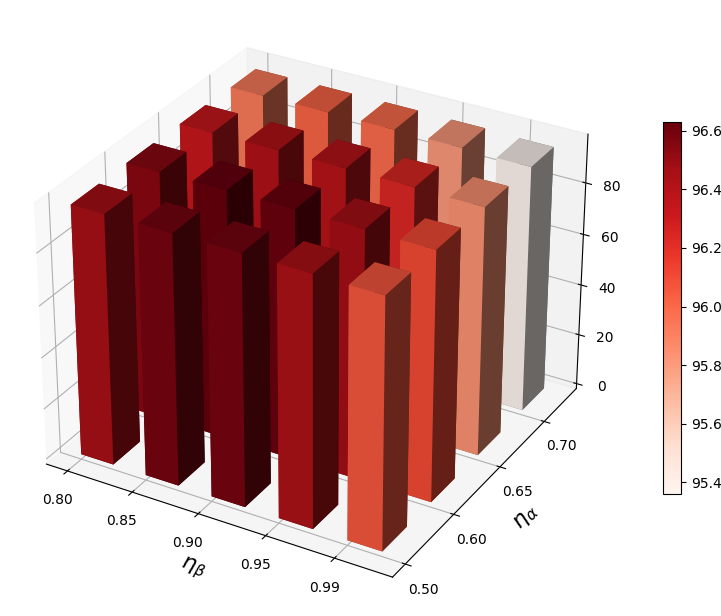
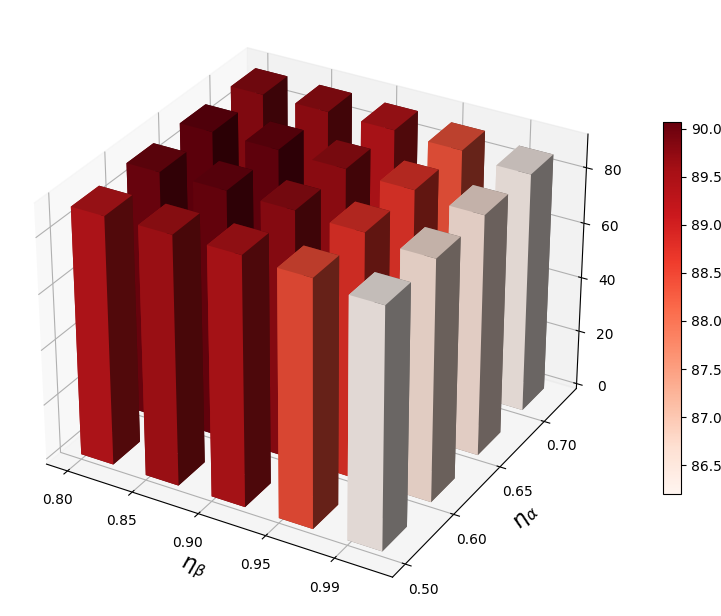
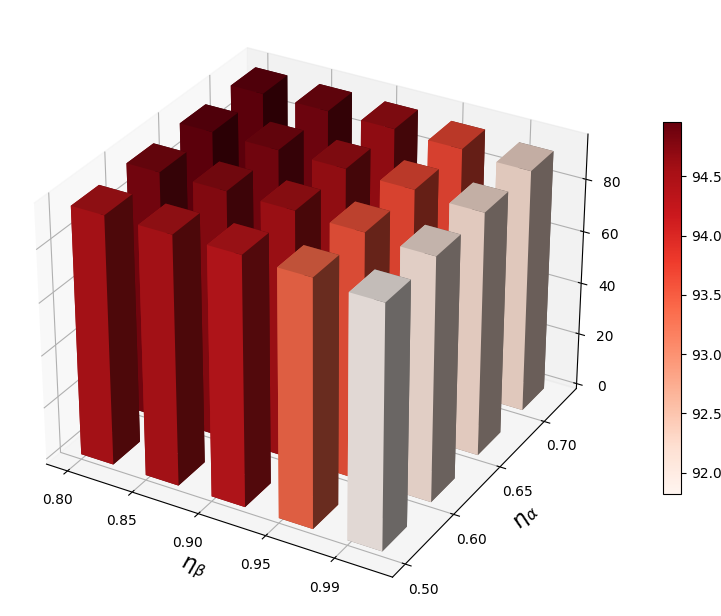
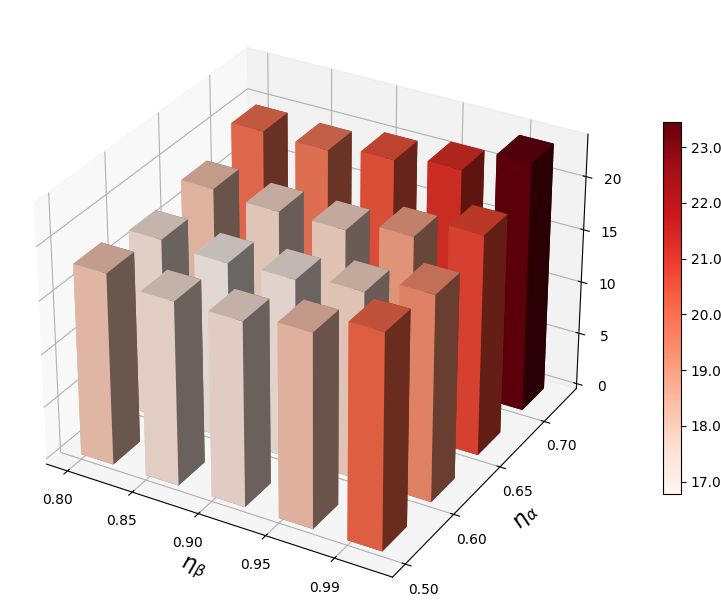
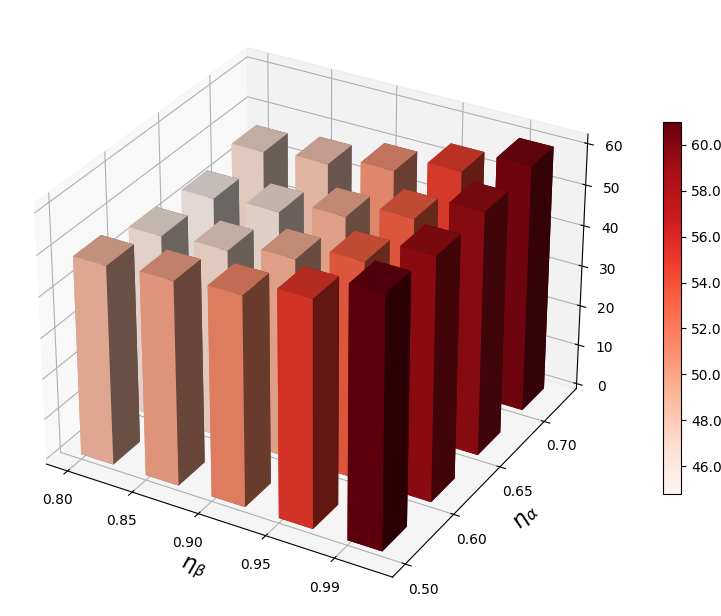
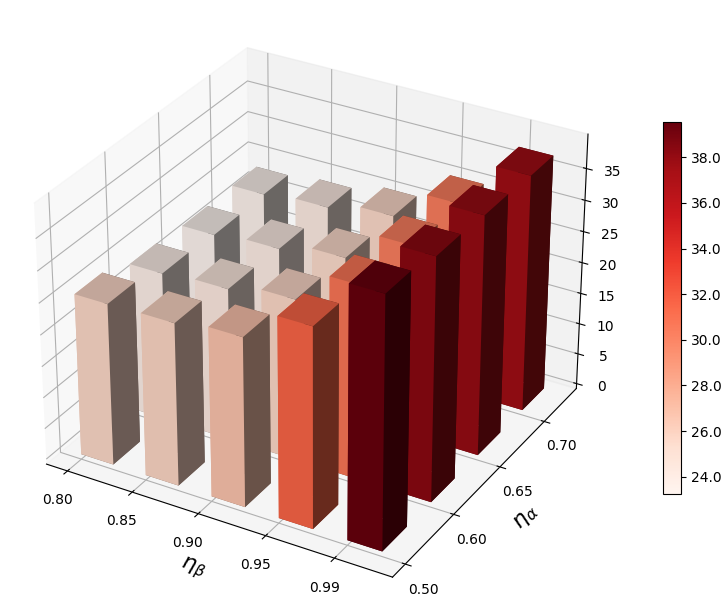
自适应调整策略的作用
在本文中,我们采用自适应策略来自动确定和。 为了验证其有效性,我们将此自适应策略与另一种针对不同特征使用固定 和 的策略进行比较。 为了确定这些超参数,我们使用高斯噪声图像作为验证集,与之前的工作[8]一致。 表5中的实验结果表明我们的自适应策略优于该固定策略。 原因在于不同的特征具有不同的统计分布。 对不同的特征使用固定的阈值会限制OOD检测的性能。
| ID | Strategy | Hyper-parameters | OOD Performance | ||||
|---|---|---|---|---|---|---|---|
| FPR95 | AUROC | ||||||
| CIFAR-10 | assign , | 0.50 | 1.50 | – | – | 19.44 | 96.34 |
| assign , | – | – | 0.60 | 0.95 | 17.74 | 96.47 | |
| CIFAR-100 | assign , | 0.50 | 1.50 | – | – | 56.35 | 86.09 |
| assign , | – | – | 0.60 | 0.95 | 47.12 | 90.21 | |
与骨干网的兼容性
在本节中,我们进一步验证我们的方法与不同骨干网的兼容性。 为了公平比较,所有方法都在 ImageNet 上进行预训练,并且我们报告了 ImageNet 的四个 OOD 数据集的平均结果。 与竞争性事后策略相比,表6中的实验结果表明,我们的方法可以在不同网络架构下实现最佳性能。 这些结果验证了我们方法的有效性和兼容性。 同时,我们在表6中观察到一些有趣的现象。 ReAct [8] 指出 ID 和 OOD 之间不匹配的 BatchNorm [30] 统计信息导致模型对 OOD 数据过度自信。 表6中,VGG-16和VGG-16-BN分别指没有和有BatchNorm的模型。 我们观察到,无论有没有 BatchNorm,ReAct 都无法实现比 Energy 更好的性能,这与之前的发现一致[31]。 因此,BatchNorm可能不是模型过度自信的唯一原因,网络架构也很重要。 此外,除了 EfficientNetV2 之外,Energy [23] 总体性能优于 MSP [20],这也暴露了其兼容性方面的局限性。 未来我们将进行深入分析,揭示这些现象背后的原因。
| Backbone | MSP | Energy | ReAct+Energy | VRA+Energy | ||||
|---|---|---|---|---|---|---|---|---|
| FPR95 | AUROC | FPR95 | AUROC | FPR95 | AUROC | FPR95 | AUROC | |
| ResNet-18 [28] | 69.70 | 80.61 | 58.59 | 80.40 | 36.36 | 92.17 | 34.87 | 92.58 |
| ResNet-34 [28] | 68.84 | 81.19 | 57.20 | 86.84 | 32.23 | 93.08 | 30.63 | 93.46 |
| ResNet-50 [28] | 66.95 | 81.99 | 58.40 | 86.17 | 31.43 | 92.95 | 25.49 | 94.57 |
| ResNet-101 [28] | 64.70 | 82.47 | 54.84 | 87.29 | 31.68 | 93.03 | 25.80 | 94.36 |
| ResNet-152 [28] | 61.35 | 83.74 | 50.39 | 88.61 | 26.57 | 94.22 | 22.21 | 95.20 |
| VGG-16 [32] | 67.94 | 81.60 | 54.33 | 88.17 | 67.81 | 83.68 | 32.99 | 92.59 |
| VGG-16-BN [32] | 65.92 | 82.00 | 50.49 | 89.03 | 59.02 | 86.34 | 35.12 | 92.05 |
| EfficientNetV2 [33] | 57.57 | 83.96 | 75.29 | 71.10 | 48.28 | 88.01 | 43.81 | 89.76 |
| RegNet [34] | 65.37 | 82.85 | 59.46 | 85.51 | 34.65 | 92.53 | 26.18 | 94.55 |
| MobileNetV3 [35] | 67.99 | 82.14 | 60.49 | 87.80 | 60.72 | 87.82 | 56.65 | 89.30 |
4进一步分析
将特征与 logit 输出相结合可以在 OOD 检测中获得更好的性能[36]。 因此,我们设计了VRA的另一种变体VRA++,其评分函数定义为:
| (16) |
其中 表示第 个特征, 表示第 个 logit 输出。 这个评分函数由两项组成:(1)由于我们已经最大化了ID和OOD之间的差距,因此我们直接使用所有校正特征的总和作为指标; (2) 我们还计算了 OOD 检测的 logit 输出的能量得分。 这些项目使用平衡因子组合。 与使用分段函数的 VRA 不同,我们进一步测试二次函数 的性能。 通过选择适当的,该二次函数还可以模拟抑制和放大操作。 最后,我们的评分函数定义为:
| (17) |
在所有方法中,ViM [36] 是一种结合了特征和 logit 输出的强大策略。 为了与 ViM 进行公平比较,我们使用相同的 ID 数据 (ImageNet)、OOD 数据 (OpenImage-O [36]、Texture [12]、iNaturalist [18]、ImageNet-O [37])和网络架构(BiT [38])。 表7中的实验结果表明VRA++取得了比ViM更好的性能,验证了我们方法的可扩展性和巨大潜力。 同时,VRA++ 通常在所有变体中实现了最佳性能(见表8)。 这些结果进一步证明了在 OOD 检测中结合特征和 logit 输出的必要性。
| Method | OpenImage-O | Texture | iNaturalist | ImageNet-O | Average | |||||
|---|---|---|---|---|---|---|---|---|---|---|
| FR. | AU. | FR. | AU. | FR. | AU. | FR. | AU. | FR. | AU. | |
| MSP [20] | 73.72 | 84.16 | 76.65 | 79.80 | 64.09 | 87.92 | 96.85 | 57.12 | 77.83 | 77.25 |
| ODIN [21] | 72.83 | 85.64 | 74.07 | 81.60 | 70.75 | 86.73 | 96.85 | 63.00 | 78.63 | 79.24 |
| Mahalanobis [22] | 64.32 | 83.10 | 14.05 | 97.33 | 64.95 | 85.70 | 70.05 | 80.37 | 53.34 | 86.63 |
| Energy [23] | 73.42 | 84.77 | 73.91 | 81.09 | 74.98 | 84.47 | 96.40 | 63.59 | 79.68 | 78.48 |
| ReAct [8] | 54.97 | 88.94 | 50.25 | 90.64 | 48.60 | 91.45 | 91.70 | 67.07 | 61.38 | 84.52 |
| ViM [36] | 43.96 | 91.54 | 04.69 | 98.92 | 55.71 | 89.30 | 61.50 | 83.87 | 41.47 | 90.91 |
| VRA++ | 34.94 | 93.55 | 05.02 | 98.76 | 22.25 | 96.37 | 60.45 | 84.21 | 30.67 | 93.22 |
| Method | CIFAR-10 | CIFAR-100 | ImageNet (Net1) | ImageNet (Net2) | ||||
|---|---|---|---|---|---|---|---|---|
| FPR95 | AUROC | FPR95 | AUROC | FPR95 | AUROC | FPR95 | AUROC | |
| VRA | 17.74 | 96.47 | 47.12 | 90.21 | 25.49 | 94.57 | 34.95 | 93.34 |
| VRA+ | 15.89 | 96.90 | 43.31 | 90.61 | 23.32 | 94.96 | 30.85 | 93.78 |
| VRA++ | 15.52 | 96.87 | 35.20 | 91.80 | 18.63 | 95.75 | 25.92 | 94.60 |
5相关工作
事后法
事后策略是 OOD 检测的一个重要分支。 由于其易于实施,它们越来越受到研究人员的关注。 其中,MSP[20]是最基本的事后策略,直接利用后验分布的最大值作为指标。 从那时起,研究人员提出了各种事后方法。 例如,ODIN [21] 使用温度缩放和输入扰动来提高 ID 和 OOD 数据的可分离性。 Energy [23] 用理论上保证的能量分数替换了 MSP [20] 中的 softmax 置信度分数。 Mahalanobis [22] 使用距类中心的最小距离来识别 OOD 数据。 KNN [24] 是一种探索 K 最近邻的非参数方法。 最近,研究人员发现模型对 OOD 数据过度自信的原因在于少数神经元的异常高激活。 为了解决这个问题,Dice [10] 使用权重稀疏化,而 ReAct [8] 利用激活截断。 与这些工作不同的是,我们进一步证明异常低的激活也会影响 OOD 检测性能。 这促使我们提出 VRA 来纠正激活函数。
激活函数
激活函数是神经网络的重要组成部分[39, 40]。 此前,研究人员发现,具有 ReLU 激活函数的神经网络对远离训练数据的输入产生异常高的激活,从而损害了已部署系统的可靠性[41]。 为了解决这个问题,ReAct 使用截断操作来纠正激活函数。 在本文中,我们提出了一种更强大的用于 OOD 检测的修正激活函数。 多个基准数据集的实验结果证明了我们方法的有效性。
变分法
变分法常用于求解函数极值。 它在神经网络中最著名的应用是变分自动编码器[42],它通过权衡重建损失和 Kullback-Leibler 散度来解决函数极值。 它还被应用于其他复杂场景[43]和多模态任务[44]。 在本文中,我们使用变分方法来寻找可以最大化ID和OOD之间差距的操作。
6结论
本文提出了一种称为 VRA 的事后 OOD 检测策略。 从变分方法的角度来看,我们找到了理论上最优的操作来最大化ID和OOD之间的差距。 该操作揭示了在 OOD 检测中抑制异常低和高激活以及放大中间激活的必要性。 因此,我们建议 VRA 来模拟这些抑制和放大操作。 实验结果表明,我们的方法优于现有的事后策略,并且与不同的评分函数和网络架构兼容。 在了解一小部分 OOD 样本的理想情况下,我们可以实现近乎完美的性能,展示了我们方法的强大潜力。 同时,我们验证了自适应调整策略的有效性并揭示了不同超参数的影响。
在本文中,我们将视为从ReAct导出的核心目标函数,将视为正则化项。 然而,可能存在更好的正则化项,既能保证最优解的存在,又能保证最优解的表达易于实现,并具有良好的可解释性。 因此,我们将探索 OOD 检测的其他正则化项。 同时,本文使用简单的分段函数来逼近复杂的最优操作。 未来,我们将探索其他能够更好地描述最优操作的函数形式。 我们还将进行深入分析,揭示 BatchNorm 和不同主干网对 OOD 检测的影响。
参考
- [1] Jingkang Yang, Pengyun Wang, Dejian Zou, Zitang Zhou, Kunyuan Ding, Wenxuan Peng, Haoqi Wang, Guangyao Chen, Bo Li, Yiyou Sun, Xuefeng Du, Kaiyang Zhou, Wayne Zhang, Dan Hendrycks, Yixuan Li, and Ziwei Liu. Openood: Benchmarking generalized out-of-distribution detection. In Proceedings of the Thirty-sixth Conference on Neural Information Processing Systems Datasets and Benchmarks Track, pages 1–14, 2022.
- [2] Alexander Amini, Ava Soleimany, Sertac Karaman, and Daniela Rus. Spatial uncertainty sampling for end-to-end control. arXiv preprint arXiv:1805.04829, 2018.
- [3] Tanya Nair, Doina Precup, Douglas L Arnold, and Tal Arbel. Exploring uncertainty measures in deep networks for multiple sclerosis lesion detection and segmentation. In Proceedings of the Medical Image Computing and Computer Assisted Intervention, MICCAI, pages 655–663, 2018.
- [4] Rui Huang and Yixuan Li. Mos: Towards scaling out-of-distribution detection for large semantic space. In Proceedings of the IEEE/CVF Conference on Computer Vision and Pattern Recognition, pages 8710–8719, 2021.
- [5] Xuefeng Du, Zhaoning Wang, Mu Cai, and Yixuan Li. Vos: Learning what you don’t know by virtual outlier synthesis. In Proceedings of the International Conference on Learning Representations, pages 1–21, 2022.
- [6] Qing Yu and Kiyoharu Aizawa. Unsupervised out-of-distribution detection by maximum classifier discrepancy. In Proceedings of the IEEE/CVF International Conference on Computer Vision, pages 9518–9526, 2019.
- [7] Jingkang Yang, Haoqi Wang, Litong Feng, Xiaopeng Yan, Huabin Zheng, Wayne Zhang, and Ziwei Liu. Semantically coherent out-of-distribution detection. In Proceedings of the IEEE/CVF International Conference on Computer Vision, pages 8301–8309, 2021.
- [8] Yiyou Sun, Chuan Guo, and Yixuan Li. React: Out-of-distribution detection with rectified activations. In Proceedings of the Advances in Neural Information Processing Systems, pages 144–157, 2021.
- [9] Christopher M Bishop. Pattern recognition and machine learning. Springer, 2006.
- [10] Yiyou Sun and Yixuan Li. Dice: Leveraging sparsification for out-of-distribution detection. In Proceedings of the European Conference on Computer Vision, pages 691–708, 2022.
- [11] Alex Krizhevsky. Learning multiple layers of features from tiny images. Technical report, University of Toronto, 2009.
- [12] Mircea Cimpoi, Subhransu Maji, Iasonas Kokkinos, Sammy Mohamed, and Andrea Vedaldi. Describing textures in the wild. In Proceedings of the IEEE Conference on Computer Vision and Pattern Recognition, pages 3606–3613, 2014.
- [13] Yuval Netzer, Tao Wang, Adam Coates, Alessandro Bissacco, Bo Wu, and Andrew Y. Ng. Reading digits in natural images with unsupervised feature learning. In NIPS Workshop on Deep Learning and Unsupervised Feature Learning, pages 1–9, 2011.
- [14] Bolei Zhou, Agata Lapedriza, Aditya Khosla, Aude Oliva, and Antonio Torralba. Places: A 10 million image database for scene recognition. IEEE Transactions on Pattern Analysis and Machine Intelligence, 40(6):1452–1464, 2017.
- [15] Fisher Yu, Ari Seff, Yinda Zhang, Shuran Song, Thomas Funkhouser, and Jianxiong Xiao. Lsun: Construction of a large-scale image dataset using deep learning with humans in the loop. arXiv preprint arXiv:1506.03365, 2015.
- [16] Pingmei Xu, Krista A Ehinger, Yinda Zhang, Adam Finkelstein, Sanjeev R Kulkarni, and Jianxiong Xiao. Turkergaze: Crowdsourcing saliency with webcam based eye tracking. arXiv preprint arXiv:1504.06755, 2015.
- [17] Jia Deng, Wei Dong, Richard Socher, Li-Jia Li, Kai Li, and Li Fei-Fei. Imagenet: A large-scale hierarchical image database. In Proceedings of the IEEE Conference on Computer Vision and Pattern Recognition, pages 248–255, 2009.
- [18] Grant Van Horn, Oisin Mac Aodha, Yang Song, Yin Cui, Chen Sun, Alex Shepard, Hartwig Adam, Pietro Perona, and Serge Belongie. The inaturalist species classification and detection dataset. In Proceedings of the IEEE Conference on Computer Vision and Pattern Recognition, pages 8769–8778, 2018.
- [19] Jianxiong Xiao, James Hays, Krista A Ehinger, Aude Oliva, and Antonio Torralba. Sun database: Large-scale scene recognition from abbey to zoo. In Proceedings of the IEEE/CVF Conference on Computer Vision and Pattern Recognition, pages 3485–3492, 2010.
- [20] Dan Hendrycks and Kevin Gimpel. A baseline for detecting misclassified and out-of-distribution examples in neural networks. In Proceedings of the International Conference on Learning Representations, pages 1–12, 2017.
- [21] Shiyu Liang, Yixuan Li, and R Srikant. Enhancing the reliability of out-of-distribution image detection in neural networks. In Proceedings of the 6th International Conference on Learning Representations, pages 1–27, 2018.
- [22] Kimin Lee, Kibok Lee, Honglak Lee, and Jinwoo Shin. A simple unified framework for detecting out-of-distribution samples and adversarial attacks. In Proceedings of the Advances in Neural Information Processing Systems, pages 7167–7177, 2018.
- [23] Weitang Liu, Xiaoyun Wang, John Owens, and Yixuan Li. Energy-based out-of-distribution detection. In Proceedings of the Advances in Neural Information Processing Systems, pages 21464–21475, 2020.
- [24] Yiyou Sun, Yifei Ming, Xiaojin Zhu, and Yixuan Li. Out-of-distribution detection with deep nearest neighbors. In Proceedings of the International Conference on Machine Learning, pages 20827–20840, 2022.
- [25] Jinsong Zhang, Qiang Fu, Xu Chen, Lun Du, Zelin Li, Gang Wang, Shi Han, and Dongmei Zhang. Out-of-distribution detection based on in-distribution data patterns memorization with modern hopfield energy. In Proceedings of the Eleventh International Conference on Learning Representations, pages 1–19, 2023.
- [26] Hubert Ramsauer, Bernhard Schäfl, Johannes Lehner, Philipp Seidl, Michael Widrich, Lukas Gruber, Markus Holzleitner, Thomas Adler, David Kreil, Michael K Kopp, Günter Klambauer, Johannes Brandstetter, and Sepp Hochreiter. Hopfield networks is all you need. In Proceedings of the International Conference on Learning Representations, pages 1–95, 2021.
- [27] Gao Huang, Zhuang Liu, Laurens Van Der Maaten, and Kilian Q Weinberger. Densely connected convolutional networks. In Proceedings of the IEEE/CVF Conference on Computer Vision and Pattern Recognition, pages 4700–4708, 2017.
- [28] Kaiming He, Xiangyu Zhang, Shaoqing Ren, and Jian Sun. Deep residual learning for image recognition. In Proceedings of the IEEE Conference on Computer Vision and Pattern Recognition, pages 770–778, 2016.
- [29] Adam Paszke, Sam Gross, Francisco Massa, Adam Lerer, James Bradbury, Gregory Chanan, Trevor Killeen, Zeming Lin, Natalia Gimelshein, Luca Antiga, et al. Pytorch: an imperative style, high-performance deep learning library. In Proceedings of the 33rd International Conference on Neural Information Processing Systems, pages 8026–8037, 2019.
- [30] Sergey Ioffe and Christian Szegedy. Batch normalization: Accelerating deep network training by reducing internal covariate shift. In Proceedings of the International Conference on Machine Learning, pages 448–456, 2015.
- [31] Yeonguk Yu, Sungho Shin, Seongju Lee, Changhyun Jun, and Kyoobin Lee. Block selection method for using feature norm in out-of-distribution detection. arXiv preprint arXiv:2212.02295, 2022.
- [32] Karen Simonyan and Andrew Zisserman. Very deep convolutional networks for large-scale image recognition. arXiv preprint arXiv:1409.1556, 2014.
- [33] Mingxing Tan and Quoc Le. Efficientnetv2: Smaller models and faster training. In Proceedings of the International Conference on Machine Learning, pages 10096–10106, 2021.
- [34] Ilija Radosavovic, Raj Prateek Kosaraju, Ross Girshick, Kaiming He, and Piotr Dollár. Designing network design spaces. In Proceedings of the IEEE/CVF Conference on Computer Vision and Pattern Recognition, pages 10428–10436, 2020.
- [35] Andrew Howard, Mark Sandler, Grace Chu, Liang-Chieh Chen, Bo Chen, Mingxing Tan, Weijun Wang, Yukun Zhu, Ruoming Pang, Vijay Vasudevan, et al. Searching for mobilenetv3. In Proceedings of the IEEE/CVF International Conference on Computer Vision, pages 1314–1324, 2019.
- [36] Haoqi Wang, Zhizhong Li, Litong Feng, and Wayne Zhang. Vim: Out-of-distribution with virtual-logit matching. In Proceedings of the IEEE/CVF Conference on Computer Vision and Pattern Recognition, pages 4921–4930, 2022.
- [37] Dan Hendrycks, Kevin Zhao, Steven Basart, Jacob Steinhardt, and Dawn Song. Natural adversarial examples. In Proceedings of the IEEE/CVF Conference on Computer Vision and Pattern Recognition, pages 15262–15271, 2021.
- [38] Alexander Kolesnikov, Lucas Beyer, Xiaohua Zhai, Joan Puigcerver, Jessica Yung, Sylvain Gelly, and Neil Houlsby. Big transfer (bit): General visual representation learning. In Proceedings of the European Conference on Computer Vision, pages 491–507, 2020.
- [39] Vinod Nair and Geoffrey E Hinton. Rectified linear units improve restricted boltzmann machines. In Proceedings of the International Conference on Machine Learning, pages 807–814, 2010.
- [40] Dan Hendrycks and Kevin Gimpel. Gaussian error linear units (gelus). arXiv preprint arXiv:1606.08415, 2016.
- [41] Matthias Hein, Maksym Andriushchenko, and Julian Bitterwolf. Why relu networks yield high-confidence predictions far away from the training data and how to mitigate the problem. In Proceedings of the IEEE/CVF Conference on Computer Vision and Pattern Recognition, pages 41–50, 2019.
- [42] Diederik P Kingma and Max Welling. Auto-encoding variational bayes. In Proceedings of the International Conference on Learning Representations, pages 1–14, 2014.
- [43] Bing Yu et al. The deep ritz method: a deep learning-based numerical algorithm for solving variational problems. Communications in Mathematics and Statistics, 6(1):1–12, 2018.
- [44] Gaurav Pandey and Ambedkar Dukkipati. Variational methods for conditional multimodal deep learning. In Proceedings of the International Joint Conference on Neural Networks (IJCNN), pages 308–315, 2017.